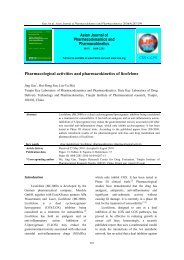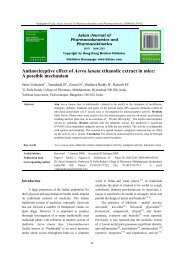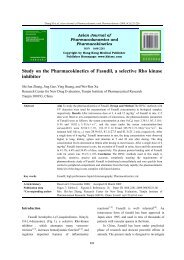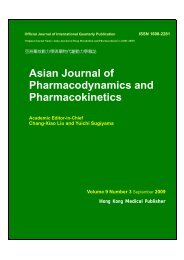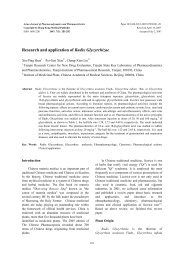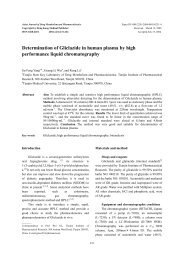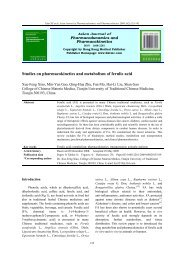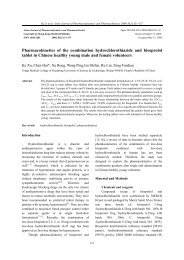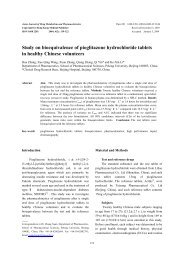Asian Journal of Pharmacodynamics and Pharmacokinetics
Asian Journal of Pharmacodynamics and Pharmacokinetics
Asian Journal of Pharmacodynamics and Pharmacokinetics
You also want an ePaper? Increase the reach of your titles
YUMPU automatically turns print PDFs into web optimized ePapers that Google loves.
Xu HY et al. <strong>Asian</strong> <strong>Journal</strong> <strong>of</strong> <strong>Pharmacodynamics</strong> <strong>and</strong> <strong>Pharmacokinetics</strong> 2009; 9(1):11-25<br />
percentage <strong>of</strong> LC in TP <strong>and</strong> the L/C ratio was<br />
significantly lower in all the test drug treated groups<br />
than those in the model group, respectively (P < 0.01),<br />
especially prominent in the group treated with giant<br />
knotweed rhizome. Although lowering <strong>of</strong> the two<br />
indexes presented in all <strong>of</strong> the groups treated by<br />
notoginseng saponins, Coptis chinensis <strong>and</strong> giant<br />
knotweed rhizome, significant difference still<br />
presented between giant knotweed rhizome treated<br />
group vs notoginseng saponins <strong>and</strong> Coptis chinensis<br />
treated group (P < 0.05). As for the expressions <strong>of</strong><br />
GM-CSF <strong>and</strong> TNF-α, in comparing with the<br />
untreated model group, significant decreasing <strong>of</strong> the<br />
TNF-α showed only in the rhubarb treated group,<br />
while that <strong>of</strong> GM-CSF could be found in all the test<br />
drug treated groups (P < 0.05). All the four drugs<br />
tested in the recommended dosage can stabilize the<br />
vulnerable plaques in ApoE knockout mice by<br />
improving the constitution <strong>of</strong> plaque, among them,<br />
giant knotweed rhizome <strong>and</strong> rhubarb, the drugs<br />
possess both the actions <strong>of</strong> activating blood<br />
circulation <strong>and</strong> detoxicating, show more significant<br />
effect, <strong>and</strong> their mechanisms may be related to their<br />
actions in regulating lipid metabolism <strong>and</strong> inhibiting<br />
inflammatory reaction. [38]<br />
We known that vascular smooth muscle cell<br />
(SMC) proliferation plays an important role in the<br />
pathogenesis <strong>of</strong> atherosclerosis <strong>and</strong> post-angioplasty<br />
restenosis. Berberine is a well-known component <strong>of</strong><br />
Coptis chinensis, <strong>and</strong> is capable <strong>of</strong> inhibiting SMC<br />
contraction <strong>and</strong> proliferation, yet the exact<br />
mechanism is unknown. Therefore, Liang KW et al<br />
investigated the effect <strong>of</strong> berberine on SMC growth<br />
after mechanic injury in vitro. DNA synthesis <strong>and</strong><br />
cell proliferation assay were performed to show that<br />
berberine inhibited serum-stimulated rat aortic SMC<br />
growth in a concentration-dependent manner.<br />
Mechanical injury with sterile pipette tip stimulated<br />
the regrowth <strong>of</strong> SMCs. Treatment with berberine<br />
prevented the regrowth <strong>and</strong> migration <strong>of</strong> SMCs into<br />
the denuded trauma zone. Western blot analysis<br />
showed that activation <strong>of</strong> the MEK 1/2<br />
(mitogen-activated protein kinase 1/2 ), extracellular<br />
signal-regulated kinase (ERK), <strong>and</strong> up-regulation <strong>of</strong><br />
early growth response gene (Egr-1), c-Fos <strong>and</strong> Cyclin<br />
D1 were observed sequentially after mechanic injury<br />
in vitro. Semi-quantitative reverse-transcription PCR<br />
assay further confirmed the increase <strong>of</strong> Egr-1, c-Fos,<br />
platelet-derived growth factor (PDGF) <strong>and</strong> Cyclin D1<br />
expression in a transcriptional level. However,<br />
berberine significantly attenuated MEK/ERK<br />
activation <strong>and</strong> downstream target (Egr-1, c-Fos,<br />
Cyclin D1 <strong>and</strong> PDGF-A) expression after mechanic<br />
injury in vitro. Their study showed that berberine<br />
blocked injury-induced SMC regrowth by<br />
inactivation <strong>of</strong> ERK/Egr-1 signaling pathway thereby<br />
preventing early signaling induced by injury in vitro.<br />
The anti-proliferative properties <strong>of</strong> berberine may be<br />
useful in treating disorders due to inappropriate SMC<br />
growth. [39]<br />
Berberine was considered to be useful in<br />
treating some diseases <strong>of</strong> the cardiovascular system,<br />
such as hypertension <strong>and</strong> chronic heart failure (CHF).<br />
Hong Y et al investigated the inhibitory effect <strong>of</strong><br />
berberine on experimental cardiac hypertrophy,<br />
which is regarded as a risk factor <strong>of</strong> CHF <strong>and</strong> other<br />
heart diseases. Forty-two male SD rats were divided<br />
into four groups: age-matched control, aortic b<strong>and</strong>ing<br />
model, berberine-treated group <strong>and</strong> captopril-treated<br />
group. Cardiac hypertrophy was induced by<br />
suprarenal abdominal aorta constriction. These drugs<br />
were orally administered for 8 weeks starting from 4<br />
weeks after surgery at dosage <strong>of</strong> berberine 10 mg·kg -1<br />
<strong>and</strong> captopril 50 mg·kg -1 . Blood pressure (BP) was<br />
measured four times during the period <strong>of</strong> the<br />
experiment, <strong>and</strong> hemodynamic parameters, cardiac<br />
index, cell size <strong>of</strong> left ventricular myocardium <strong>and</strong><br />
total protein <strong>of</strong> left ventricular tissue were detected 8<br />
weeks after treatment with these drugs. The data from<br />
the present study showed that: The BP <strong>of</strong> the aorta<br />
b<strong>and</strong>ed rats was increased compared with those <strong>of</strong> the<br />
normal (P < 0.001) <strong>and</strong> the age-matched control rats<br />
(P< 0.001), <strong>and</strong> berberine showed no significant<br />
effect on it; after 8 weeks <strong>of</strong> treatment with berberine,<br />
the elevated left ventricular end diastolic pressure<br />
(LVEDP) was slightly decreased compared with the<br />
aortic b<strong>and</strong>ed rats. Meanwhile, the maximum rates <strong>of</strong><br />
contraction <strong>and</strong> relaxation (± dp/dtmax) was<br />
increased (P < 0.05) <strong>and</strong> the time to reach the point<br />
<strong>of</strong> maximum rate from beginning <strong>of</strong> contraction<br />
(t-dp/dt) was shortened (P < 0.01), indicating that the<br />
functions <strong>of</strong> heart, both contraction <strong>and</strong> relaxation,<br />
were improved; cardiac growth was inhibited by<br />
treatment with berberine. Both whole heart <strong>and</strong> left<br />
ventricular weight were notably decreased compared<br />
with the b<strong>and</strong>ed rats (P < 0.05 <strong>and</strong> P < 0.01); <strong>and</strong> the<br />
17



